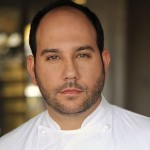
Jeffrey Nimer
Whether a holiday gathering or sit-down dinner, Jeffrey Nimer says a good piece of meat makes the meal. Here, Haute Chefs’ Executive Chef Jeffrey Nimer details the Dos and the Don’ts of prime rib preparation.
Interviewing Experts: Jeffrey, thank you for taking time out to chat with us today.
Jeffrey Nimer: It’s my pleasure; I’ll always talk about food!
Interviewing Experts: What’s your favorite cut of meat when cooking for a crowd?
Jeffrey Nimer: I love standing rib roasts and really any prime rib in general.
Interviewing Experts: Prime… that’s the grade of the meat, right?
Jeffrey Nimer: It can be, but typically beef graded as Prime is reserved for fine steakhouses and butcher shops. Grocery store prime rib is most likely a Choice cut.
Interviewing Experts: How are these cuts graded? What makes one better than the other?
Jeffrey Nimer: It’s the marbling, which is the little veins of fat that run through the meat. More visible marbling means the meat with cook into a more tender and flavorful dish.
Interviewing Experts: I’ve heard that you are an expert in Standing Rib Roasts… Can you tell our readers exactly what that means?
Jeffrey Nimer: A standing roast is just one that has the bones intact and can literally stand up without assistance.
Interviewing Experts: It sounds like a large piece of meat. Isn’t that difficult?
Jeffrey Nimer: Not really if you get ready ahead of time.
Interviewing Experts: By…?
Jeffrey Nimer: First, let the meat come to room temperate before subjecting it to high heat. It will cook unevenly if the center temperature is very different from the outside. Also, make sure to tie the entire roast. If it is allowed to pull away from the bone, it will lose flavor.
Interviewing Experts: What about the fat on the outside of the meat?
Jeffrey Nimer: You want to trim it down to less than one inch thick; this will make the roast much better than if it did not have any fat basting it.
Interviewing Experts: What sort of temperature should it be cooked at?
Jeffrey Nimer: I’ve said it a million times and I’ll repeat it now: Low and Slow. Low and Slow. The oven temp should be no more than 160 degrees – and that’s for a well-done prime.
Interviewing Experts: Any last tips for the novice rib roaster?
Jeffrey Nimer: Don’t cut the roast with a dull knife…and, try serving with Yorkshire Pudding.
Jeffrey Nimer’s passion for food dates back to his childhood, where his grandfather let him wander around the kitchen of the family’s café. Today, Chef Nimer uses his skills and inherent love of food to craft the perfect combination of local and fresh produce and meats with dazzling presentations.
To contact Jeffrey Nimer visit hautechefsofla.com or check out his profile on Social Culinaire, a food-lovers networking site at socialculinaire.com.